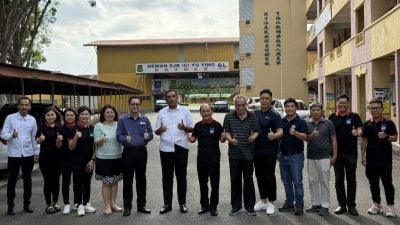Preamble
Malaysia’s equity market continues to underperform against regional peers, as reflected by anemic total shareholder returns of the FBM KLCI—below fixed deposit yields over the past decade.
The recent net foreign outflows in financial services (-RM835.5 million), healthcare (-RM270.3 million), and utilities (-RM106.7 million) signal not only short-term investor retrenchment but also deeper structural vulnerabilities in the economy.
Rising global protectionism, slowing external demand, and rapid technological transformation—especially in artificial intelligence (AI)—require Malaysia to critically reassess its economic direction.
Without strategic realignment, Malaysia risks entrenching itself in a semi-peripheral dependency position within global value chains, unable to convert digital and industrial transitions into broad-based prosperity.
Financial services: Toward digital productivity
The financial services sector, traditionally a major attractor of foreign capital, now faces outflows due to weak asset performance, high household debt, and low real returns.
The banking system’s exposure to property and consumption credit reflects a rentier bias that undermines productive capital formation.
According to Bank Negara Malaysia (BNM, 2025), financial deepening has not translated into inclusive growth; lending to small and medium enterprises (SMEs) remains under 40 percent of total business credit.
Amid global protectionism and monetary tightening, Malaysia must pivot toward AI-driven financial productivity rather than speculative liquidity.
One defined objective in The National AI Strategy 2024–2030 is to lay a path for embedding predictive analytics and credit-risk automation into lending models, allowing banks to enhance SME credit access while reducing non-performing loans.
This transition requires retraining financial professionals, integrating open data platforms, and aligning capital markets with sustainable and digital sectors.
Moreover, regulatory institutions such as the Securities Commission (SC) should incentivize AI-based financial governance, blockchain auditing, and algorithmic compliance systems to improve transparency.
Strengthening digital finance ecosystems would not only attract green and impact investors but also restore confidence in Malaysia’s capital market integrity.
Healthcare: Building AI-enabled bioeconomy and resilient supply chains
The healthcare sector’s RM270.3 million foreign outflow underscores how Malaysia remains highly dependent on imported biopharmaceutical technologies and global supply chains dominated by U.S. and EU firms.
Despite strong fundamentals in medical tourism and private hospital expansion, the sector’s innovation value chain remains weak.
On one aspect, local firms often occupy low-level, low-margin assembly or distribution roles instead of upgrading to upstream R&D.
To reverse this positioning, Malaysia should transition toward an AI-enabled bioeconomy, integrating machine-learning in diagnostics, drug discovery, and genomic analytics.
The Malaysia Healthcare Travel Council (MHTC) can partner with AI startups to develop predictive health models for Southeast Asian demographics, while the Bioeconomy Corporation could establish joint ventures with domestic universities to produce AI-assisted clinical datasets, leveraging Malaysia’s diverse genomic base.
Additionally, healthcare resilience requires localizing production of pharmaceutical inputs and medical devices, reducing exposure to global protectionistic trade policies.
Malaysia can emulate South Korea’s AI Bio Hub model, creating biomedical innovation clusters in Penang and Johor linked to public health data centers.
This approach aligns with the Twelfth and Thirteenth Malaysia Plans’ (RMK12 & RMK13) goals of fostering value-added industrial ecosystems under digital industrial policy.
Utilities and green transition: AI for resource optimization
Utilities—particularly energy and water—recorded RM106.7 million in foreign outflows, indicating investor skepticism over Malaysia’s green transition credibility.
Despite policy rhetoric, fossil fuel dependency and regulatory fragmentation hinder Malaysia’s decarbonization pathway.
The National Energy Transition Roadmap (NETR, 2024) sets an ambitious 70 percent renewable energy capacity target by 2050, but its realization hinges on financial innovation and AI-driven operational efficiency.
AI can optimize grid management, predictive maintenance, and demand forecasting, substantially lowering operational costs and carbon intensity. For instance, Tenaga Nasional Berhad (TNB) could deploy AI-based digital twins for smart grid analytics, enhancing renewable integration while maintaining grid stability.
Similarly, water utilities could adopt AI leak detection and climate risk modeling, particularly for drought-prone states.
However, to attract capital back into utilities, transparent carbon accounting, green bond issuance, and ESG-aligned AI audits have to become mainstream.
The Ministry of Natural Resources and Environmental Sustainability (NRES) could coordinate AI-driven decarbonization data systems to enable measurable investor confidence.
At one perspective, these pivots not only advance sustainability goals but also reposition Malaysia as a regional leader in AI-based resource governance.

Cross-sectoral imperatives: Reindustrialization through AI and human capital reform
A unifying challenge across sectors lies in the digital skill gap and Malaysia’s slow-moving industrial reconfiguration.
Although the Digital Economy Blueprint (MyDigital) envisions an AI-driven economy contributing 25.5 percent to GDP by 2025, most firms—especially SMEs —remain technologically underprepared; indeed, our national total factor productivity index has remained 1 percent for decades.
Meanwhile, global reshoring trends and protectionism threaten Malaysia’s export-oriented model dependent on foreign technology and capital.
Therefore, to counteract these vulnerabilities, Malaysia must begin to initiate a reindustrialization strategy anchored in AI integration, green manufacturing, and sovereign technological capacity.
Public investment should prioritize domestic semiconductor R&D, algorithmic transparency, and AI ethics frameworks.
The Human Resource Development Corporation (HRD Corp) should redirect training subsidies toward machine-learning engineering, data ethics, and applied AI for production and knowledge processes.
These measures would foster overall mobility within the digital economy, enabling Malaysia to move beyond the role of a passive technology consumer.
Furthermore, fiscal policy must reward AI adoption in productive sectors, not merely digital retail or fintech applications.
Tax credits for AI-driven process automation, coupled with equity co-investment via Khazanah Nasional’s Dana Impak, can accelerate sectoral modernization and attract sustainable foreign participation.
Conclusion: From financial outflows to structural renewal
Malaysia’s challenge is not a cyclical downturn but a structural misalignment between capital, technology, and production.
The recent foreign outflows in financial services, healthcare, and utilities reflect investor apprehension about Malaysia’s long-term productivity prospects amid protectionism and AI-driven global competition.
A credible path forward demands state-led digital industrial policy—balancing AI innovation with social inclusion, industrial upgrading, and sustainable growth.
By embedding artificial intelligence within its financial, healthcare, and utility sectors, Malaysia can transform structural weaknesses into competitive strengths.
The future of Malaysian economic resilience depends not on chasing speculative inflows, but on building endogenous technological capacity, fostering inclusive digital labor, and reasserting economic sovereignty in an era defined by algorithmic capitalism.
References:
Bank Negara Malaysia. (2025). Financial Stability Review: First Half 2025. Kuala Lumpur: BNM.
Department of Statistics Malaysia. (2025). Quarterly Economic Performance Report. Putrajaya: DOSM.
Ministry of Economy. (2024). National Energy Transition Roadmap (NETR). Putrajaya: Government of Malaysia.
Ministry of Science, Technology, and Innovation (2024). National Artificial Intelligence Strategy 2024–2030. Kuala Lumpur: MOSTI.
Securities Commission Malaysia. (2025). Capital Market Review. Kuala Lumpur: SC.
World Bank. (2024). Malaysia Economic Monitor: Digital Horizons. Washington, DC: World Bank.
IMF. (2024). Asia-Pacific Regional Economic Outlook: Navigating Structural Slowdown. Washington, DC: IMF.
(CS Loh is a retired private higher education institute lecturer, postgraduated as an development economist with reference to Southeast Asia from the School of Oriental and Asian Studies (SOAS), University of London.)
ADVERTISEMENT
ADVERTISEMENT








































